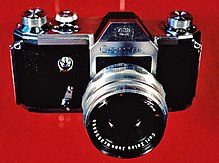Photography
hotography is the art, science, and practice of creating pictures by recording radiation on a radiation-sensitive medium, such as a photographic film, or electronic image sensors. Photography uses foremost radiation in the UV, visible and near-IR spectrum.[1] For common purposes the term light is used instead of radiation. Light reflected or emitted from objects form a real image on a light sensitive area (film or plate) or a FPA pixel array sensor by means of a pin hole or lens in a device known as a camera during a timed exposure. The result on film or plate is a latent image, subsequently developed into a visual image (negative or diapositive). An image on paper base is known as a print. The result on the FPA pixel array sensor is an electrical charge at each pixel which is electronically processed and stored in a computer (raster)-image file for subsequent display or processing. Photography has many uses for business, science, manufacturing (f.i. Photolithography), art, and recreational purposes.
Lens and mounting of a large-format camera.
A modern digital camera.
As far as can be ascertained, it was Sir John Herschel in a lecture before the Royal Society of London, on March 14, 1839 who made the word "photography" known to the world. But in an article published on February 25 of the same year in a German newspaper called the Vossische Zeitung, Johann von Maedler, a Berlin astronomer, had used the word photography already.[2] The word photography is based on the Greek φῶς (photos) "light" and γραφή (graphé) "representation by means of lines" or "drawing", together meaning "drawing with light".[3]






